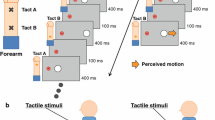Abstract
The motion aftereffect (MAE) refers to the apparent motion of a stationary stimulus following adaptation to a continuously moving stimulus. There is a growing consensus that the fast adapting (FA) rather than the slowly adapting (SA) afferent units mediate the tactile version of the MAE. The present study investigated which FA units underlie the tactile MAE by measuring its prevalence, duration, and vividness on different skin areas that vary in their composition of FA units. Specifically, the right cheek, volar surface of the forearm, and volar surface of the hand were adapted using a ridged cylindrical drum, which rotated at 60 rpm for 120 s. Although there was no difference in duration or vividness between the skin surfaces tested, the tactile MAE was reported twice as often on the hand compared to the cheek and forearm, which did not differ significantly from one another. This suggests that the FA I units in the glabrous skin and the hair follicle and/or the FA I and field units in the hairy skin contribute to the tactile MAE.



Similar content being viewed by others
References
Barlow SM (1987) Mechanical frequency detection thresholds in the human face. Exp Neurol 96:253–261
Brainard DH (1997) The psychophysics toolbox. Spat Vis 10:433–436
Collins DF, Refshauge KM, Todd G, Gandevia SC (2005) Cutaneous receptors contribute to kinesthesia at the index finger, elbow, and knee. J Neurophysiol 94:1699–1706
Darian-Smith I (1973) The trigeminal system. In: Iggo A (ed) Handbook of sensory physiology: vol II, somatosensory system. Springer, New York, pp 273–314
Dillon YK, Haynes J, Henneberg M (2001) The relationship of the number of Meissner’s corpuscles to dermatoglyphic characters and finger size. J Anat 199:577–584
Gardner EP, Palmer IC (1989) Simulation of motion on the skin. I. Receptive fields and temporal frequency coding by cutaneous mechanoreceptors of Optacon pulses delivered to the hand. J Neurophysiol 63:1410–1436
Greenspan JD, Bolanowski SJ (1996) The psychophysics of tactile perception and its peripheral basis. In: Kruger L (ed) Handbook of perception and cognition, vol 7, pain and touch. Academic Press, San Diego, pp 25–103
Hall GS, Donaldson HH (1885) Motor sensations on the skin. Mind 10:557–572
Hazlewood V (1971) A note on failure to find a tactile motion aftereffect. Aust J Psychol 23:59–62
Holcombe AO, Seizova-Cajic T (2008) Illusory motion reversals from unambiguous motion with visual, proprioceptive, and tactile stimuli. Vis Res 48:1743–1757
Hollins M, Favorov O (1994) The tactile movement aftereffect. Somatosens Mot Res 11:153–162
Hollins M, Delemos KA, Goble AK (1991) Vibrotactile adaptation on the face. Percept Psychophys 49:21–30
Johansson RS (1976) Receptive sensitivity profile of mechanoreceptive units innervating the glabrous skin of the human hand. Brain Res 104:330–334
Johansson RS (1978) Tactile sensibility of the human hand: receptive field characteristics of mechanoreceptive units in the glabrous skin. J Physiol 281:101–123
Johansson RS, Olsson KA (1976) Micro-electrode recording from human oral mechanoreceptors. Brain Res 188:307–311
Johansson RS, Vallbo ÅB (1979) Tactile sensibility in the human hand: relative and absolute densities of four types of mechanoreceptive units in glabrous skin. J Physiol 286:283–300
Johansson RS, Trulsson M, Olsson KÅ, Westberg K-G (1988) Mechanoreceptor activity from the human face and oral mucosa. Exp Brain Res 72:204–208
Johnson KO (2001) The roles and functions of cutaneous mechanoreceptors. Curr Opin Neurobiol 11:455–461
Lerner EA, Craig JC (2002) The prevalence of tactile motion aftereffects. Somatosens Mot Res 19:24–29
Lindblom U (1965) Properties of touch receptors in distal glabrous skin. J Neurophysiol 28:966–985
Olausson H, Wessberg J, Kakuda N (2000) Tactile directional sensibility: peripheral neural mechanisms in man. Brain Res 866:178–187
Planetta PJ, Servos P (2008) The tactile motion aftereffect revisited. Somatosens Mot Res 25:93–99
Schimrigk K, Rüttinger H (1980) The touch corpuscles of the palmar surface of the big toe. Histological and histometrical investigations with respect to age. Eur Neurol 19:49–60
Thalman WA (1922) The after-effect of movement in the sense of touch. Am J Psychol 33:268–276
Trulsson M, Essick GK (1997) Low-threshold mechanoreceptive afferents in the human lingual nerve. J Neurophysiol 77:737–748
Vallbo ÅB, Johansson RS (1984) Properties of cutaneous mechanoreceptors in the human hand related to touch sensation. Hum Neurobiol 3:3–14
Vallbo ÅB, Olausson H, Wessberg J, Kakuda N (1995) Receptive field characteristics of tactile units with myelinated afferents in hairy skin of human subjects. J Physiol 483:783–795
Watanabe J, Hayashi S, Kajimoto H, Tachi S, Nishisa S (2007) Tactile motion aftereffects produced by appropriate presentation for mechanoreceptors. Exp Brain Res 180:577–582
Willis WD Jr (2008) Physiological characteristics of second-order somatosensory circuits in spinal cord and brainstem. In: Basbaum AI, Kaneko A, Shepard GM, Westheimer G, Kaas JH, Gardner EP (eds) The senses: a comprehensive reference, vol 6, somatosensation. Academic Press, Amsterdam, pp 87–116
Wohlgemuth A (1911) On the after-effect of seen movement. Br J Psychol Monogr Suppl 1:88–109
Acknowledgments
This work was supported by the Canada Research Chairs program (P.S.) and the Natural Sciences and Engineering Research Council (NSERC) of Canada (P.S.). P.J.P. was supported by an NSERC postgraduate scholarship.
Author information
Authors and Affiliations
Corresponding author
Rights and permissions
About this article
Cite this article
Planetta, P.J., Servos, P. Site of stimulation effects on the prevalence of the tactile motion aftereffect. Exp Brain Res 202, 377–383 (2010). https://doi.org/10.1007/s00221-009-2144-3
Received:
Accepted:
Published:
Issue Date:
DOI: https://doi.org/10.1007/s00221-009-2144-3



